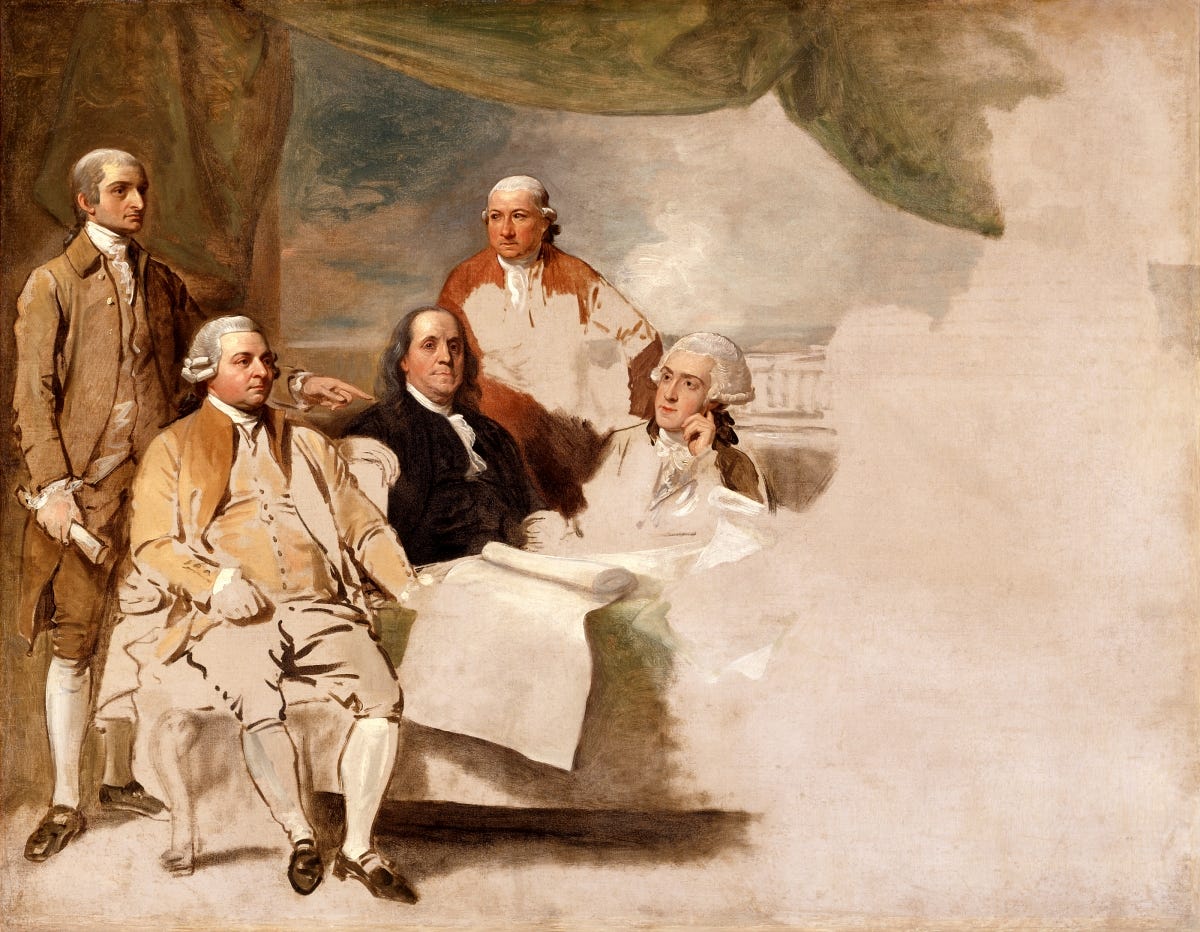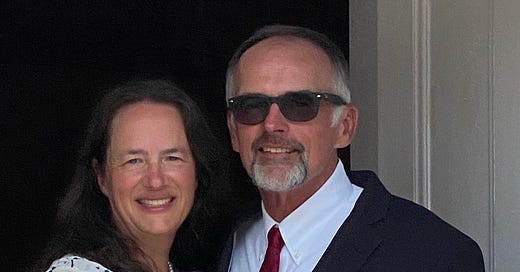
Today is officially Ratification Day, the anniversary of the day in 1784 when members of the Confederation Congress ratified the Treaty of Paris that ended the Revolutionary War and formally recognized the independence of the United States from Great Britain.
It almost didn’t happen.
On September 3, 1783, negotiators John Adams, Benjamin Franklin, and John Jay for the United States, and David Hartley for Great Britain, had signed the document establishing the United States as an independent and sovereign nation.
British officer Lord Cornwallis’s surrender of 8,000 men to General George Washington on October 19, 1781, after the Battle of Yorktown had made it clear that Britain would have to agree to the independence of its former colonies, but the representatives of those colonies didn’t have a lot to bargain with to shape the peace in their favor. What they did have was the ability to play different European powers off against each other, for the American Revolution, after all, was only a piece of a global conflict that included Great Britain, France, Spain, the Dutch Republic, Jamaica, Gibraltar, and India.
Peace negotiations began in Paris in April 1782 and stretched on through the summer and into the fall. The United States were allied with France, which in 1778, just two years after the Declaration of Independence, had come to the rescue of the fledgling nation in its struggle with Great Britain. Spain and the Dutch Republic, too, sided with the Americans, hoping they could carve their way out from under King George, thus weakening Great Britain and enabling the European nations to take more global territory.
With all these parties involved, negotiations were slow and sticky, especially as Spain wanted to continue to fight until it could capture Gibraltar from the British. (The Great Siege of Gibraltar, which took more than three and a half years, was actually the largest battle of the war in terms of combatants.) At the same time, French foreign minister Charles Gravier, comte de Vergennes, was frustrated with the continuing cost of the American war and, in fall 1782, proposed a plan that would offer independence to the United States but offer Spain something it would value as much as Gibraltar: more land in North America. Essentially, the plan would keep the new nation hemmed in where it already was, dividing the land around it between Britain and Spain.
U.S. negotiator John Jay, who as minister to Spain during the war had been instrumental in convincing Spain to loan money to the United States, immediately turned to the British to negotiate without France and Spain. British prime minister Lord Shelburne saw an opportunity to split the new country off from France and set it up as a trading partner until—as would most likely happen—its radical new government fell apart and Britain could reassert control.
The document was a testament to the negotiating skills of the U.S. team. They got independence, of course, as well as a promise “to forget all past Misunderstandings and Differences that have unhappily interrupted the good Correspondence and Friendship which they mutually wish to restore.” All prisoners of war would be repatriated, no reparations would be demanded, and state legislatures were urged to provide restitution for the confiscated lands of British subjects (a provision that the U.S. government had no power to enforce). The treaty left Britain in possession of Canada but threw out Vergennes’s suggestion and established the western boundary of the new nation at the Mississippi River, although it left the northern and southern boundaries of the new nation vague. It then gave both Americans and British the right to transport goods along that watery highway. It also gave the United States exceedingly valuable fishing rights on the Grand Banks of Newfoundland and in the Gulf of Saint Lawrence.
But then it said: “The solemn Ratifications of the present Treaty expedited in good & due Form shall be exchanged between the contracting Parties in the Space of Six Months or sooner if possible to be computed from the Day of the Signature of the present Treaty.”
That is, Congress had six months from the September 3 signing to get the treaty across the Atlantic Ocean, ratify the agreement, and get it back across the ocean to England. The voyages alone could take as much as two months each way.
That put pressure on Congress to act quickly, but the Congress that represented the United States in that era was organized under the Articles of Confederation, a weak and loose agreement of “a firm league of friendship” that the thirteen original states adopted on November 15, 1777. That national government had little power, and those lawmakers interested in real power worked in their own states to build new governments.
Congress was supposed to convene at the Maryland State House in November, but it was a terribly cold winter, and delegates trickled in. As late as January 12, only seven of the thirteen states were represented, and Congress needed nine states to ratify the treaty. Finally, a delegate from Connecticut arrived. Then, on January 13, Richard Beresford of South Carolina, who had been ill in Philadelphia, finally made it to the gathering. Congress had a quorum, and it approved the treaty on January 14.
“By the United States in Congress assembled, A PROCLAMATION,” read the document the Congress had printed to spread the news of the treaty. It reproduced the terms of the agreement, then said, “AND we the United States in Congress assembled, having seen and duly considered the definitive articles aforesaid, did…approve, ratify and confirm the same.”
Seeming to recognize the extraordinary significance of their actions, the congressmen continued: “[W]e have thought proper…to notify…all the good citizens of these United States…that reverencing those stipulations entered into on their behalf, under the authority of that federal bond by which their existence as an independent people is bound up together, and is known and acknowledged by the nations of the world, and with that good faith which is every man’s surest guide…they carry into effect the said…articles, and every clause and sentence thereof, sincerely, strictly, and completely.”
The document was signed by the president of the Congress, his excellency Thomas Mifflin, a name few people now remember, for while the long, difficult, and meticulous negotiations and then the fitful energies of Congress had achieved an agreement that the former colonies were now independent, it would not be until the ratification of the United States Constitution in 1788 that the new nation finally began yet another long difficult journey to become the United States of America.
[Treaty of Paris by Benjamin West (1783), Winterthur Museum, Winterthur, Delaware, image in public domain. This is the American delegation; the British delegation refused to pose for the painter, who could not complete the work.]
Notes:
https://www.archives.gov/milestone-documents/articles-of-confederation
https://www.archives.gov/milestone-documents/treaty-of-paris
https://www.loc.gov/resource/bdsdcc.09001
—












Holy smokes, Heather ! This is one of the most interesting letters you’ve written thus far (my opinion). Such history, which we weren’t taught in school. Thank you !!
I was carried back with your descriptions to that time. Amazing to think about the frigid winter and the difficult journey between England and the new country, ours. I loved your final comment about the Brits refusing to pose for the painting to memorialize our freedom and the historic Treaty....and thus it was only half-finished by the artist. Heather, you are an awesome historian, teacher and have become a “friend” to thousands of your readers. Thank you for being so wonderful!